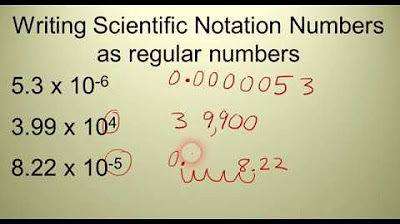Scientific Notation: Introduction
Summary
TLDRThis video explains scientific notation, a method to simplify writing and working with very large or very small numbers commonly used in science. The speaker demonstrates how to convert numbers to and from scientific notation, emphasizing its usefulness in avoiding errors when dealing with zeros in calculations. Step-by-step examples show how to move decimal places and adjust exponents, depending on the direction of the shift. The video concludes with a recommendation to watch a follow-up video for a deeper understanding of the math behind scientific notation.
Takeaways
- 🔢 Scientific notation is a shorthand way to write very large or very small numbers.
- 🌌 It's crucial in science for dealing with astronomical distances like the miles from Earth to the closest star.
- 🕒 It's also used for extremely small measurements, like the time light takes to travel across a room.
- 📏 Scientific notation simplifies calculations by reducing the number of zeros to count and manage.
- 📉 To convert a large number, place the decimal after the first non-zero digit and multiply by 10 raised to the number of places moved.
- 📈 For small numbers, move the decimal to the right to create a single non-zero digit before the decimal, then use a negative exponent.
- 📚 The exponent in scientific notation indicates the number of decimal places moved.
- 🔄 Moving the decimal to the left increases the exponent, while moving it to the right decreases it.
- 📐 Practice is key to mastering the conversion between regular and scientific notation.
- 📈 To convert scientific notation back to standard form, move the decimal point to the right for positive exponents and to the left for negative exponents, filling in zeros as necessary.
Q & A
What is scientific notation and why is it important?
-Scientific notation is a shorthand way to write very large or very small numbers, making them easier to work with. It's important in science because it allows for easier calculations when dealing with extremely large or small values, such as the distance between stars or the weight of subatomic particles.
How does scientific notation help with large and small numbers?
-It helps by reducing the need to write and calculate with many zeros. Instead of writing out a large number like 25,300,000,000,000, we can write it as 2.53 × 10^13, which is much more compact and manageable.
What are the steps to convert a large number into scientific notation?
-1. Identify where the decimal point should be in the original number (often implied at the end for whole numbers). 2. Move the decimal point so that there is only one non-zero digit to its left. 3. Count how many places you moved the decimal and use this number as the exponent of 10.
What is the rule for determining the exponent in scientific notation when dealing with large numbers?
-For large numbers, the exponent is positive and equals the number of places the decimal point was moved to the left. For example, moving the decimal point 13 places to the left gives an exponent of +13.
How do you convert a very small number to scientific notation?
-1. Move the decimal point to the right until there is only one non-zero digit to its left. 2. Count how many places you moved the decimal. 3. Use the negative of that number as the exponent of 10.
What is the rule for determining the exponent in scientific notation when dealing with small numbers?
-For small numbers, the exponent is negative and equals the number of places the decimal point was moved to the right. For example, moving the decimal 8 places to the right gives an exponent of -8.
How do you convert a number written in scientific notation back to decimal form?
-To convert a number from scientific notation to decimal form, move the decimal point the number of places indicated by the exponent. Move it to the right for positive exponents and to the left for negative exponents.
Why is it important to understand the underlying math behind scientific notation?
-Understanding the underlying math helps you grasp how exponents work and why scientific notation functions the way it does. This deeper understanding makes it easier to use scientific notation accurately and confidently.
How does the direction of moving the decimal point affect the exponent in scientific notation?
-When you move the decimal point to the left, the exponent becomes positive, and when you move it to the right, the exponent becomes negative.
Why is scientific notation considered easier for calculations, especially in science?
-It simplifies multiplication, division, and comparison of large and small numbers by focusing on the significant figures and powers of 10, instead of working with cumbersome zeros.
Outlines

此内容仅限付费用户访问。 请升级后访问。
立即升级Mindmap

此内容仅限付费用户访问。 请升级后访问。
立即升级Keywords

此内容仅限付费用户访问。 请升级后访问。
立即升级Highlights

此内容仅限付费用户访问。 请升级后访问。
立即升级Transcripts

此内容仅限付费用户访问。 请升级后访问。
立即升级浏览更多相关视频

Introduction to scientific notation | Pre-Algebra | Khan Academy

FISIKA DASAR KELAS X | NOTASI ILMIAH.

Scientific Notation

Perpangkatan dan Bentuk Akar [Part 8] - Notasi Ilmiah

NOTAÇÃO CIENTÍFICA | Física, Química 8°, 9° ano , conceito e exercícios | Potencia base 10

BAB 6 Notasi Ilmiah | Matematika Dasar | Alternatifa
5.0 / 5 (0 votes)
